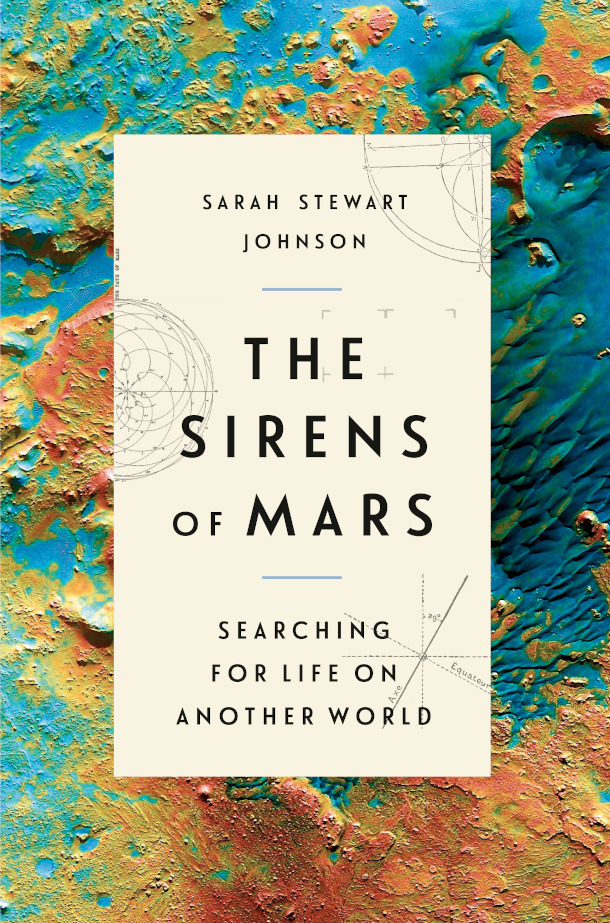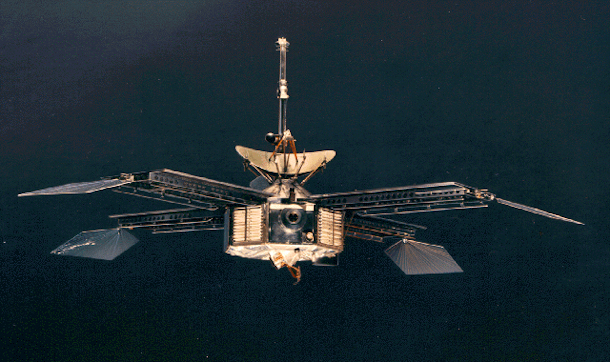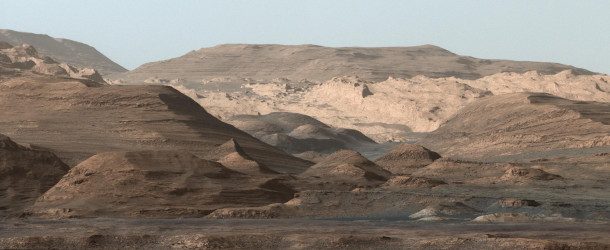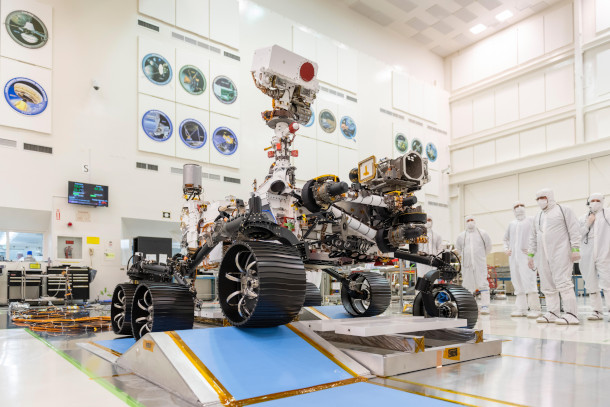The Sirens of Mars
Air Date: Week of July 17, 2020

Sarah Stewart Johnson is the author of Sirens of Mars: Searching for Life on Another World. (Photo: Courtesy of Penguin Random House)
The search for life elsewhere in the Universe is focused now on Mars, our closest planetary neighbor, with the Perseverance mission planned to launch sometime between the end of July and the middle of August. Astrobiologist Sarah Stewart Johnson is a Georgetown associate professor and NASA scientist who has spent her career searching for answers to these questions. Her book Sirens of Mars: Searching for Life on Another World captures the intersection between planetary science and her life's journey, and she joins Host Steve Curwood to explore the big questions that define space exploration and the human species’ fascination with Mars.
Transcript
BASCOMB: It’s Living on Earth, I’m Bobby Bascomb.
CURWOOD: And I’m Steve Curwood
It’s ironic that we use robots to search for life elsewhere in the universe but if and when we do find evidence of it, a machine will tell us. And few people on planet earth are more intrigued with those missions than astrobiologist Sarah Stewart Johnson.
Based at Georgetown University, professor Johnson works closely with NASA on the design, build and operation of robotic systems being sent to Mars to try to discover life, past or present. The latest American suite of interplanetary robotic life hunters is called Perseverance, with a launch window between July 30th and August 15th. Over the years as she has teamed up to worked on this epic quest Sarah Stewart Johnson has also kept a notebook. And lucky for us she has just published her thoughts and experiences these in a fascinating book called Sirens of Mars: Searching for Life on Another World. I asked how she would like to be the leader of one these missions:
JOHNSON: You know, I am just captivated by this idea of are we alone, and searching for life in the universe, and these big questions. You know, where did we come from? And why is there something and not nothing? Did that something from nothing, did it happen once? Or did it happen time and again? And we're at this moment in human history when we have the tools to answer those questions. And the idea of leading a life detection mission, someday just would be the most thrilling thing ever. I just feel so driven to try to get to answers to those questions. And now we have a way to do that with instruments and with planetary missions.
CURWOOD: Speaking of instrumentation, the first successful flyby of Mars happened in 1965. We're talking about more than 55 years ago. Sarah, give us, please, a brief history of the missions to Mars that have happened since.
JOHNSON: So, this was just a watershed moment, all of a sudden, we just went to Mars. We had our first flyby mission in 1965, the Mariner 4 mission. And this mission was just very small, it was about the power of a pocket calculator. And it was designed to make a number of measurements about the environment. And it also collected 21 photographs of the planet's surface, and each one of those took eight hours to relay back to Earth. And when those images were put together, it was just staggeringly disappointing because one of the things that those images revealed was that the surface of Mars was covered with ancient craters. And this meant number one, Mars had no plate tectonics and number two, there was no fluid erosion of any sort that would have erased those craters, and it meant the surface was ancient and there had been no water there and it was just pockmarked, like the moon. And we just really were not expecting that. I'm not sure we knew what we were expecting. But it was just this hard moment, and the New York Times even declared that Mars was a dead planet at that point. Fortunately, we didn't cease from exploration, you know, we continued to go back, we sent more flyby missions, two in 1969. 1971, we had Mariner 9, which was the very first mission to go into orbit. And it made a number of tremendous discoveries. But one of them was that the surface of Mars was covered with ancient rivers, and that there were all of these features that had to have been created by water. So, even though there was no water today, on the surface in liquid form, even though the pressure was too low, and the temperature was too cold, Mars was a much different place in the ancient past. And then not long after, later in the 1970s, we sent two orbiters, the Viking orbiters. And they each released a lander, the Viking 1 and 2 landers. And they did the very first life detection experiments on the surface of Mars. And, you know, those experiments were very confounding, the results. At first there is this enormous response from one of the three life detection instruments, to the point where some of the team members called off for champagne and cigars, thinking that they had just made the biggest discovery in the history of modern science. But then those results, they just sort of dropped off unexpectedly. And then there were the controls, which were supposed to be negative, had these big results as well in two of the three experiments. And then the real kicker was that there was a chemistry instrument that was looking for the building blocks of life, these carbon containing organic molecules, and there were none whatsoever detected. And this was perplexing because even on the moon, even on other planetary bodies, there's a ssp of rain, of these abiotic organic molecules down from space and there were just none at all, which was a big mystery. But, you know, the broad conclusion of those experiments was that no life was detected, the surface was just very bleak, you know, covered in this red dust that was the consistency of cigarette smoke.

The Mariner 4 spacecraft launched on November 28th in 1964 performed the first successful flyby of Mars. (Photo: NASA, Public Domain)
CURWOOD: Well, wait, I thought there was supposed to be Martians there. And if certainly not Martians, at least there were canals that they had dug. But these flybys and these early landers don't find any of that. So if there was life on Mars, it sounds like must have happened a long, long, long, long, long, long time ago.
JOHNSON: Yeah, well, you know, I will say that we took a 20 year break from exploring Mars after those Viking missions. I think part of it was the disappointment, part of it was that there were other targets in the solar system that were becoming increasingly exciting, like the outer planets. Part of that was bad luck, there was a big mission that failed that NASA sent in the early 90s. But once we started back in 1997, NASA has been sending missions every 26 months, when the planets align on the same side of the sun. And these missions on this rough cadence of every two years have come back with astonishing findings, things that have just brought the planets into technicolor focus. And even if the surface may not be hospitable anymore, and may not be habitable because of the conditions, down deep in the subsurface, which is one of the most intriguing places to look, I think there's still a very real possibility that we could find simple microbial life. I mean, a lot of our biomass here on earth is beneath the surface in microbial form. We've barely even scratched the surface when it comes to this kind of exploration. We'll have the very first mission that will drill down to look for biosignatures or traces of life with the European mission that goes in two years, the Rosalind Franklin rover.
CURWOOD: Whoa. So you are swinging for the fences here, you could discover life on another planet in a mission that you lead. It just is really tiny, it's microbial, and way, way, way down underneath the surface. Huh.
JOHNSON: Well, maybe not even so far down, you know, even two meters down, you're below a lot of the very damaging cosmic radiation that makes it very hard for molecules to stay together at the surface. But I do feel like there's so many possibilities there, ready to be explored.

A “selfie” from the Curiosity rover, composed of 57 individual images stitched together into a panorama. (Photo: Curiosity, NASA, Public Domain)
CURWOOD: So, there are four successful rovers that have wound up on Mars. What, Sojourner, the Opportunity, Spirit and wait, there's one still going, right? It's called the Curiosity? But, what were these rovers goals and accomplishments so far? And I guess it doesn't include finding life, but maybe that's a "not yet", huh?
JOHNSON: Well, so NASA kind of went back to the drawing board when we began this new era of Mars exploration in the late 90s. It was driven, on the one hand, by this idea of a better, faster, cheaper, have more missions, have them more often. And then there was also an idea that we should follow the water. Because everywhere we looked on Earth, you know, life could be very, very different in different types of environments, but the one constant seem to be water, at least at some part of its life cycle. And so NASA's new mantra, "follow the water" kicked into place. And the very first rover that went was only the very small little thing, the Pathfinder rover, it was the size of a suitcase. It landed on July 4, and it was really more of a technological demonstration to show that there was a new type of exploration. You didn't have to just look at what was right in front of your face, you could traverse and you could get to interesting scientific targets. And then the next two rovers, these twin rovers Spirit and Opportunity followed, landing in early 2004. And these rovers were about the size of a golf cart. And they landed on opposite sides of the planet. They were only built to last 90 days. But Spirit went on for four years, and Opportunity all the way until 2018. So 14 years, over 5,000 days of exploration, it went a total of 28 miles across the surface of Mars. And in that 28 miles, all of those explorations that those two rovers did, we found out some incredibly astonishing things about the planet. And that really motivated this idea of sending a scientific laboratory to the surface, which was the Curiosity rover, or also called the Mars Science Laboratory, and that landed in 2012. It was the size of a car, you know, a metric ton. Put down on the surface, landed in the base of Gale Crater and inside Gale Crater is a mountain, and it's called Mount Sharp, and it rises higher than Mount Rainier above Seattle. And it records a very big chunk of Martian climate history. And so we can look at the sediments that have been laid down, which are sort of laid down like the pages of a history book and record the environmental conditions. And we've been exploring as we've been ascending that mountain and we're still doing that today. It's been just a really exciting campaign and Curiosity has revealed that this is a habitable environment. You know, we've moved beyond "follow the water" to understanding that all the ingredients necessary for life as we know it are there, or were there in the surface of Mars and that there was all this ancient water. Water that was pH neutral, the kind of water you could drink a glass of, had you been standing on the surface billions of years ago, you know, rushing by. And streams, you know, there could have been a big lake that filled Gale Crater, the top of the mountain might have even stood as an island. We've gone back and we've found those organic building blocks of life, those organic molecules have been detected by the Sample Analysis at Mars instrument on the Curiosity rover. And I've been fortunate to work as part of that instrument team. And so we've just done some really astonishing things there with Curiosity. And now it's time to send Perseverance.

Curiosity’s view of Mount Sharp in Gale Crater. (Photo: Curiosity Rover, NASA / JPL-Caltech, Public Domain)
CURWOOD: Perseverance, so what is in Perseverance?
JOHNSON: So, Perseverance in some ways, looks just like Curiosity. It's built on the same chassis, which saved a lot of money and a lot of design features. It'll land in the exact same way. Well, a little bit more refined. We're getting much better at targeting little landing ellipses, these days, but Perseverance has a different set of instruments. So, seven instruments that are really targeted towards spatially resolving and honing in on the best samples to collect. Because what Perseverance is doing is it's kicking off this breathtakingly ambitious campaign to return samples of Mars that are carefully selected to Earth. And it's going to take three missions to do it, and a lot of international cooperation. But the idea is that Perseverance will collect a few dozen samples about the size of a pen light, leave them in a cache on the surface, than a fetch rover will come along and pick those up and put them into an ascent vehicle. And then another vehicle will come along and collect those out of orbit and bring them back to Earth.
CURWOOD: Scientists have made plenty of guesses about the possibility of extraterrestrial life. So, what's your feeling here? This is not a scientific question. This is a feeling question. How alone are we in the universe, do you think? And if we're not, how likely are we to find evidence of life forms as close to us as Mars?

The Perseverance rover performs its first driving test on Dec. 17, 2019. The Mars 2020 mission is set to land on Mars in February of 2021. (Photo: NASA / JPL-Caltech, Public Domain)
JOHNSON: That's a great questions, Steve. And I think you're right, as a scientist, it's hard to answer because we aren't basing our feelings at this moment in data, right? But I can tell you, I feel incredibly strongly that we must keep looking. And I've got a couple of reasons for that. And of course, I would have picked a different career if I wasn't thinking that this would pay off in the end. But I think I just must underscore just how enormous that payoff would be, the idea of finding life on Mars or at another planetary target here in our solar system or beyond. So, we only have one data point for life. You know, it's the life as we know it, the life that we have here on Earth, and it's all basically the same. It's this DNA-based, carbon-based life. And it all traces back to a common origin. And as a result, I would argue that biology is largely a descriptive science. We don't have that second data point, we can't make the kind of constitutional fundamental understanding of biology. We can't make that leap yet, because we're limited. You know, we don't know if life is just a consequence of energetic systems. We don't know what paths it would follow.

Sarah Stewart Johnson is a Georgetown University Associate Professor who has worked with the NASA Science Teams for the Opportunity, Spirit, and Curiosity rovers. (Photo: Brittany Waddell)
We know that we had all the same sorts of starting ingredients that we had here on Earth, on Mars, and we know that they were there around the time that life was getting started here. And even if life on Mars had been, say, ancestrally, related to life on Earth. There were lots of rocks exchanged between the planets, especially early in their histories around the time life was getting started here. There is a chance that life just got caught from the next planet over. But even that would be remarkable, this idea of playing the tape of evolution over again and seeing what results. This idea of running that great experiment one more time would be revelatory. But I have to say the thing that excites me most is this idea of a separate genesis. A type of life that's completely different from anything that we've ever seen before. And I can tell you this, like if we find it on Mars, then you know, that's just the next planet, that's our near neighbor, it would just have huge implications, it would really imply that the universe would be positively teeming with life. You know, we're a small species in this vast universe. And our lives are just incredibly short, you know, on the scale of geologic time, and we really just have a moment to be here. And it just makes life so very precious and so very special. And we've really just got to make the very most of this one moment that we each have.
CURWOOD: Sarah Stewart Johnson is an associate professor at Georgetown University and the author of Sirens of Mars: Searching for Life on Another World. Thank you so much for taking the time with us today.
JOHNSON: Steve, thank you. This was such a pleasure to talk with you.
CURWOOD: And I do hope you find what you're looking for.
JOHNSON: Me too.
Links
Space.com | “A Brief History of Mars Missions”
Living on Earth wants to hear from you!
Living on Earth
62 Calef Highway, Suite 212
Lee, NH 03861
Telephone: 617-287-4121
E-mail: comments@loe.org
Newsletter [Click here]
Donate to Living on Earth!
Living on Earth is an independent media program and relies entirely on contributions from listeners and institutions supporting public service. Please donate now to preserve an independent environmental voice.
NewsletterLiving on Earth offers a weekly delivery of the show's rundown to your mailbox. Sign up for our newsletter today!
 Sailors For The Sea: Be the change you want to sea.
Sailors For The Sea: Be the change you want to sea.
 The Grantham Foundation for the Protection of the Environment: Committed to protecting and improving the health of the global environment.
The Grantham Foundation for the Protection of the Environment: Committed to protecting and improving the health of the global environment.
 Contribute to Living on Earth and receive, as our gift to you, an archival print of one of Mark Seth Lender's extraordinary wildlife photographs. Follow the link to see Mark's current collection of photographs.
Contribute to Living on Earth and receive, as our gift to you, an archival print of one of Mark Seth Lender's extraordinary wildlife photographs. Follow the link to see Mark's current collection of photographs.
 Buy a signed copy of Mark Seth Lender's book Smeagull the Seagull & support Living on Earth
Buy a signed copy of Mark Seth Lender's book Smeagull the Seagull & support Living on Earth

